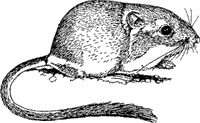Kangaroo Rats | Kangaroo Rat Overview | Kangaroo Rat Damage Assessment | Kangaroo Rat Damage Management | Kangaroo Rat Resources | ICWDM | Wildlife Species Information
Damage Prevention and Control
Exclusion
Exclusion is most often accomplished by the construction of rat-proof fences and gates around the area to be protected. Most kangaroo rats can be excluded by 1/2-inch (1.3-cm) mesh hardware cloth, 30 to 36 inches (75 to 90 cm) high. The bottom 6 inches (15 cm) should be turned outward and buried at least 12 inches (30 cm) in the ground. Exclusion may be practical for small areas of high-value crops, such as gardens, but is impractical and too expensive for larger acreages.
Cultural Methods
Alfalfa, corn, sorghum, and other grains are the most likely crops to be damaged by kangaroo rats. When possible, planting should be done in early spring before kangaroo rats become active to prevent loss of seeds. Less palatable crops should be planted along field edges that are near areas infested with kangaroo rats.
High kangaroo rat numbers most often occur on rangelands that have been subjected to overuse by livestock. Kangaroo rats usually are not abundant where rangelands have a good grass cover, since many of the forbs that provide seeds for food are not abundant in dense stands of grass. Thus, changes in grazing practices accompanied by control programs may be necessary for substantial, long-term relief.
Repellents
None are registered for repelling kangaroo rats.
Toxicants
Zinc Phosphide. At present, 2% zinc phosphide bait is federally registered for the control of the bannertail, Merriam, and Ord’s kangaroo rats in rangeland vegetation and noncrop areas. Some states may also have Special Local Needs 24(c) registrations for zinc phosphide baits to control kangaroo rats.
Zinc phosphide pelleted rodent bait was tested on kangaroo rats in New Mexico (Howard and Bodenchuk 1984). Zinc phosphide applied in June produced the highest percentage of control. Zinc phosphide is advantageous because it is thought to present little or no hazard of secondary poisoning to small canids and a low hazard to other nontarget wildlife.
Carefully read and follow all label instructions. Zinc phosphide is a Restricted Use Pesticide for retail sale to and use by certified applicators or persons under their direct supervision, and only for those uses covered by the applicator’s certification.
Fumigants
Aluminum phosphide and gas cartridges are currently registered for “burrowing rodents such as woodchucks, prairie dogs, gophers, and ground squirrels,” which also includes kangaroo rats.
Trapping
- Live Traps.
Trapping with box-type (wire cage) traps can be successful in a small area when a small number of kangaroo rats are causing problems. These traps can be baited successfully with various grains, oatmeal, oatmeal and peanut butter, and other baits. One problem is the disposal of kangaroo rats after they have been trapped. They usually die from exposure if they remain in the trap for over 6 hours. If the rats are released, they should be taken to an area more than 1 mile (1.6 km) from the problem site. The release site should provide suitable habitat and be acceptable to everyone involved. Do not release kangaroo rats in areas where landowners do not want them.
- Snap Traps.
Trapping with snap traps is probably the most efficient and humane method for kangaroo rats. Mouse traps will suffice for smaller animals, but Victor® “museum specials” or rat traps are needed for larger kangaroo rats, particularly the bannertail. Successful baits include whole kernel corn, peanut butter and oatmeal, and oatmeal paste, which are placed on the trigger mechanism. Place traps near, but not inside, the burrow entrances or along runways between mounds. Check traps each day to remove dead kangaroo rats. Reset tripped traps and replace baits that may have been removed by ants or other insects. Do not use whole kernel corn when large numbers of seed-eating songbirds are in the area.
Other Methods
If kangaroo rats from only one or two mounds are causing the problems, and water is available, they may be flushed from their burrows and either killed or allowed to go elsewhere. Collapse the mounds after the kangaroo rats have been driven out. This not only levels the surface but also allows you to detect burrow reinvasion by other kangarooa rats. Use caution when flushing burrows with water or trapping kangaroo rats. The burrow entrances are sometimes used by rattlesnakes seeking to escape heat and direct sunlight during hot days. Even on warm days, rattlesnakes may be found near mounds since kangaroo rats are a source of food for them.
Kangaroo Rats | Kangaroo Rat Overview | Kangaroo Rat Damage Assessment | Kangaroo Rat Damage Management | Kangaroo Rat Resources | ICWDM | Wildlife Species Information
Sumary of Damage Prevention and Control Methods
Exclusion
Rat-proof fences may be practical only for small areas of high-value crops.
Cultural Methods
Plant less palatable crops along field edges and encourage dense stands of rangeland grass.
Repellents
None are registered.
Toxicants
Zinc phosphide.
Fumigants
Aluminum phosphide and gas cartridges are registered for various burrowing rodents.
Trapping
Live traps. Snap traps.
Other Methods
Use water to flush kangaroo rats from burrows.

